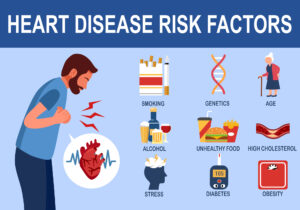In the United States, someone has a heart attack every 40 seconds. But, not every heart attack looks the same. In fact, one in five attacks are “silent,” meaning damage was done but the affected individual is not aware of it.
 The signs and symptoms of a heart attack often depend on age, gender, and any other medical conditions one might have. For example, younger people, specifically younger males, typically end up having the “classic” symptoms—crushing chest pain, radiating to the jaw or arm—whereas females and senior citizens often experience more gradual, vague symptoms.
The signs and symptoms of a heart attack often depend on age, gender, and any other medical conditions one might have. For example, younger people, specifically younger males, typically end up having the “classic” symptoms—crushing chest pain, radiating to the jaw or arm—whereas females and senior citizens often experience more gradual, vague symptoms.
Don’t Wait—Why You Need to Act Immediately
If you or a loved one suspects a heart attack, call 9-1-1 immediately and wait for the ambulance to arrive—as opposed to driving to the hospital yourself. This is because treatment for cardiac issues starts when the paramedics get to your door. They are able to start reversing the physical effects of the heart attack and address pain within seconds of starting an IV.
The entire process, from the minute you call the ambulance, is streamlined to get you to a doctor who can help you as quickly as possible. Depending on the technology available in the ambulance, an EKG can be done before the patient arrives at the hospital. Having the EKG done prior to arriving at the hospital allows the emergency room doctor and the cardiologist time to start evaluating the case even if the patient is still ten minutes away.
Diagnosing a Heart Attack
The diagnostic process for a heart attack varies depending on the severity of the symptoms. For example, if someone has been having chest pains but it’s not certain to be heart-related, a cardiologist will typically perform a stress test. This can either be in the form of an exercise stress test or a chemical stress test, which involves putting EKG leads on the patient and having them walk on the treadmill to evaluate how their heart responds to stress.
Another way to diagnose a heart attack is a cardiac cath. This is where a cardiologist squirts dye into the arterial system while taking a real-time x-ray of the arteries in the heart. The cardiologist can then see how well the dye goes through the arteries and are able to locate the occlusion and insert a stent.
Prevention Goes a Long Way
While recognizing the signs and symptoms of heart attack can save lives, individuals can also do so much for their own health by taking preventative measures. Lifestyle management steps such as weight loss, hypertension and diabetes control, and smoking cessation all have profoundly positive impacts on your cardiovascular health. Genetics do play a role, so investigate your family history as well.
Having a primary care provider is key to maintaining a healthy lifestyle. No football team is going anywhere without a quarterback. You need somebody quarterbacking your health. Make your follow-up appointments. If your doctor is trying to get you to go in for some specialty exams, definitely follow up with those.
Riverside Healthcare has primary care providers located throughout the community. Find out more about primary care providers at Riverside by visiting riversidehealthcare.org/services/primary-care
 The signs and symptoms of a heart attack often depend on age, gender, and any other medical conditions one might have. For example, younger people, specifically younger males, typically end up having the “classic” symptoms—crushing chest pain, radiating to the jaw or arm—whereas females and senior citizens often experience more gradual, vague symptoms.
The signs and symptoms of a heart attack often depend on age, gender, and any other medical conditions one might have. For example, younger people, specifically younger males, typically end up having the “classic” symptoms—crushing chest pain, radiating to the jaw or arm—whereas females and senior citizens often experience more gradual, vague symptoms.